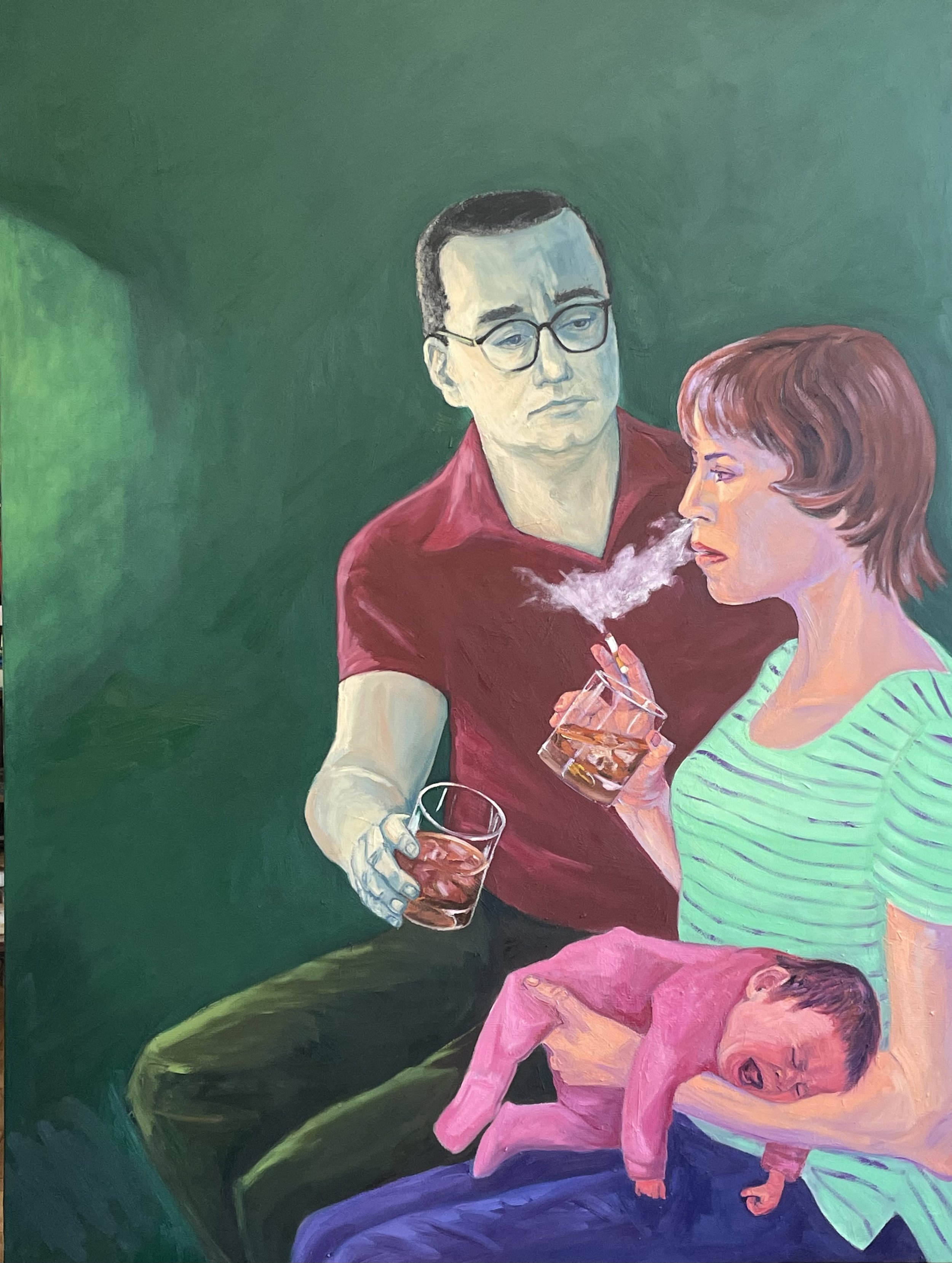Amy McCormac, Regularly Scheduled Programming, 2023, oil on canvas, 48 × 36″.
In Amy McCormac’s painting Regularly Scheduled Programming, 2023, a woman puffs clouds of smoke from her nostrils like an angry dragon. The needs of a bawling infant propped awkwardly on her left arm seem far from the woman’s mind as she fretfully gazes outward, presumably at a television outside of the composition. The man beside offers her his drink in an apparent gesture of conciliation, even though she already has her own. His worried face is pale, corpse-like; the sallow green background heightens the dismal mood. The baby here is McCormac herself, the man and woman her parents: recurring characters in her recent exhibition “What Made Her?”, an incisive autobiographical investigation of intergenerational trauma.
Although the twelve paintings in the show were not ordered chronologically, two of the walls in the gallery featured scenes from McCormac’s early years, while the canvases on the other two walls portrayed her as an adult, suggesting the cyclical nature of family dynamics. Throughout these dramatic vignettes from her life, she evoked emotion via delicately wrought facial expressions, dark outlines, and unusual symbolic colors. In Response, 2022, a florid McCormac shouts angrily at her husband as he naps in a chair, seemingly ignorant of her rage. In his deep state of repose, he appears almost dead, an effect heightened by a cool, cadaverous complexion that is similar to that of her father in Regularly Scheduled Programming.
During a lecture at the gallery, McCormac explained that she began this body of work while coming to terms with her lifelong struggles with anxiety and depression. According to the artist, she grew up in a pastoral Chicago suburb, yet her parents, “nerdy sensitive types,” didn’t conform to the archetypal suburban lifestyle, and her mother became distant, perhaps as a result of her alienation. It was only after McCormac had two daughters of her own, one of whom was diagnosed with depression at the age of seven, that she began to consider how intergenerational anxiety shaped her history.
Upon reflection, she believes her parents were deeply depressed following a late-term miscarriage that predated the birth of her and her sisters. Several of the most poignant paintings addressed how her parents, devout Catholics, insisted upon viewing the deceased baby as an integral part of the family. In Still Blue, 2018, her father presides over a pink bedroom where three little girls with worried miens say prayers while a fetal apparition looms ominously overhead.
In Not Now, 2018, McCormac as a toddler offers a cookie to her mother, who seems to be too busy smoking and ironing to pay heed. The warped one-point perspective of the banal white kitchen cabinets and flat garish patterning on the ironing board convey a claustrophobic feeling through childlike simplicity. When McCormac was a teenager, her mother, desiring a smoking companion, encouraged her to take up cigarettes. The exchange is pictured in Nurturing, 2017, wherein the manicured and jewelry-clad matriarch offers a young McCormac a light. The painting is rendered in a style that evokes girlish glamour, appearing almost as a high-school doodle or a vintage young-adult novel cover.
Whereas the off-kilter proportions and simple compositions of McCormac’s portrayals of her early years exuded a naïveté that agreed with the subject matter; the paintings of her as an adult were more technically refined, perhaps alluding to a heightened awareness of the passage of time and personal growth. Several scenes hinted at postpartum depression and alcoholism, including It Helps with Let Down, 2021, where the artist chugs a beer while breastfeeding her newborn. In Let Go of Me, 2017, her daughter, now much older, sits on the floor clutching her leg while looking pleadingly upward. McCormac meanwhile looks away—her tight-lipped expression of annoyance and crossed arms give the impression that the young woman is a burden, holding her mother back from whatever she wishes to do.
McCormac doesn’t shy away from representing distressing scenarios, consistently placing herself and her relatives in less-than-favorable lights. Combating stigmas with regard to open discussions of relational problems and childhood trauma, she lays bare her messy life for viewers to see, and perhaps to learn from.
